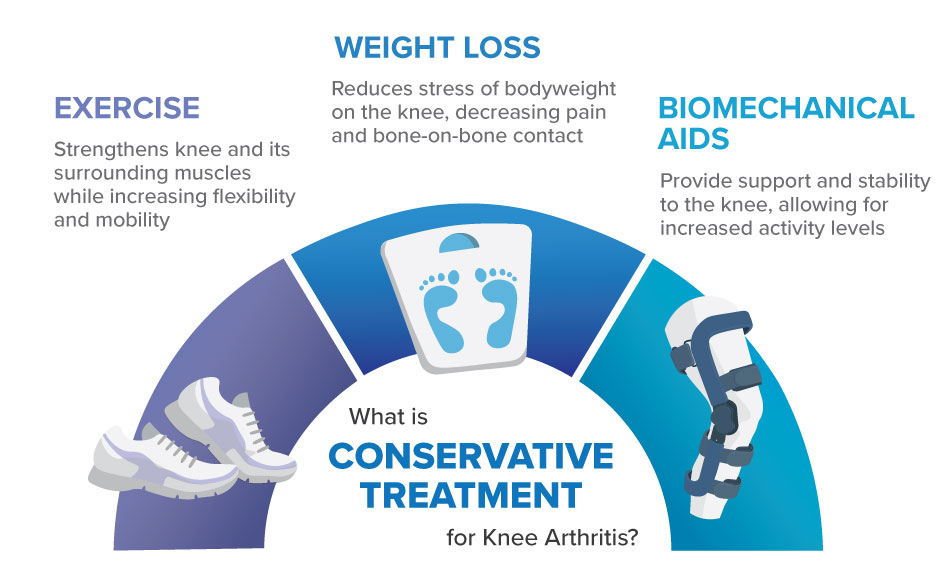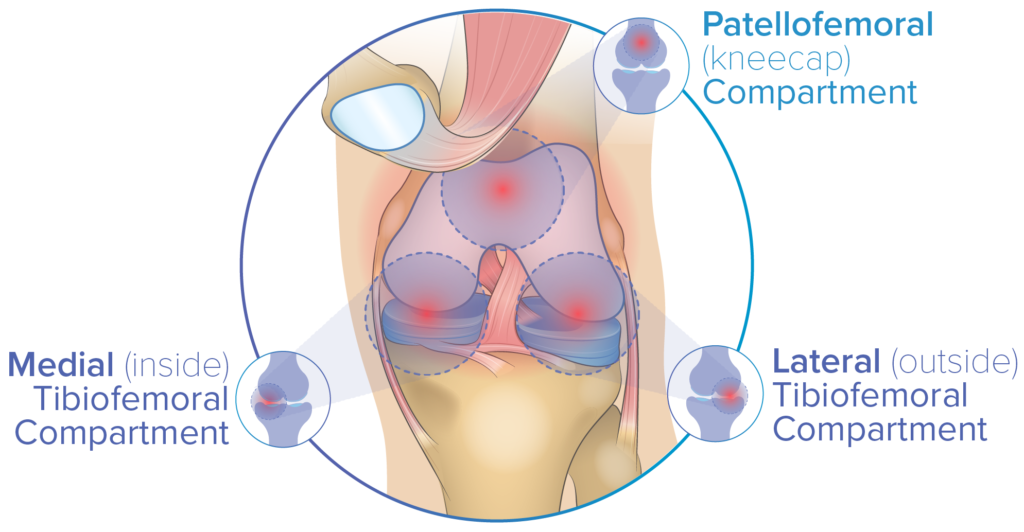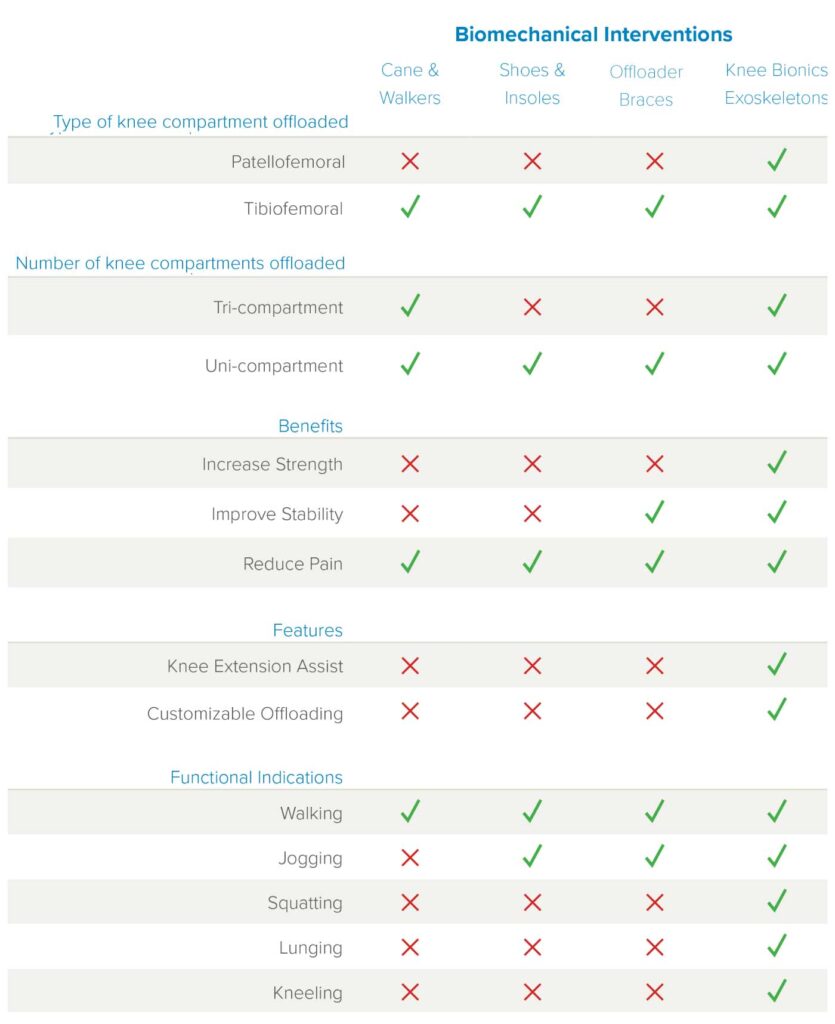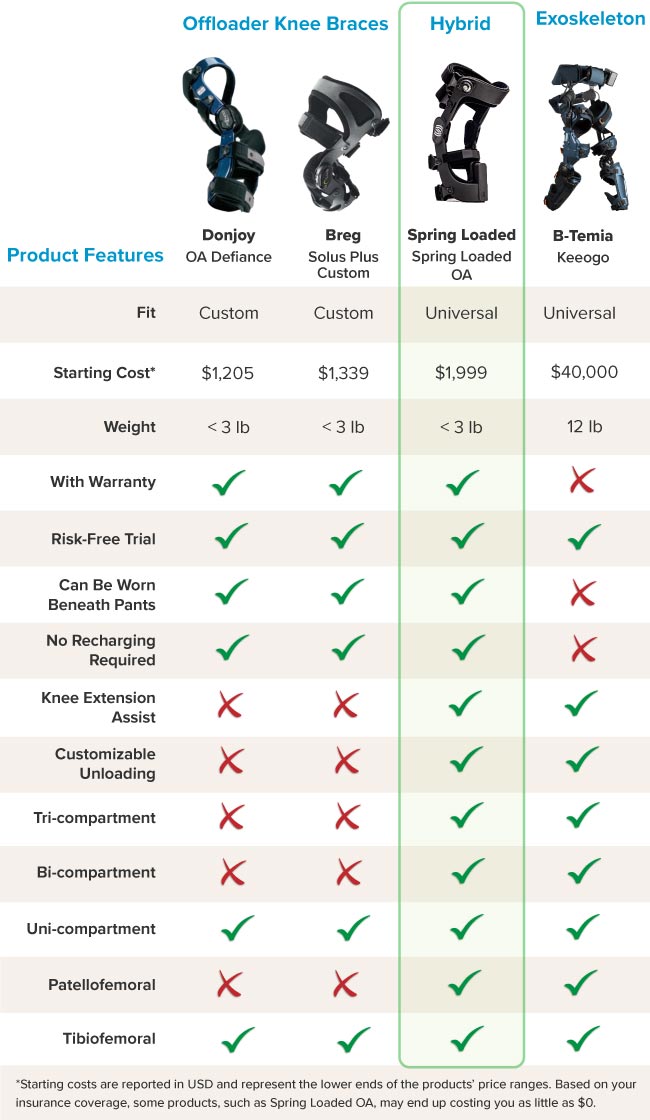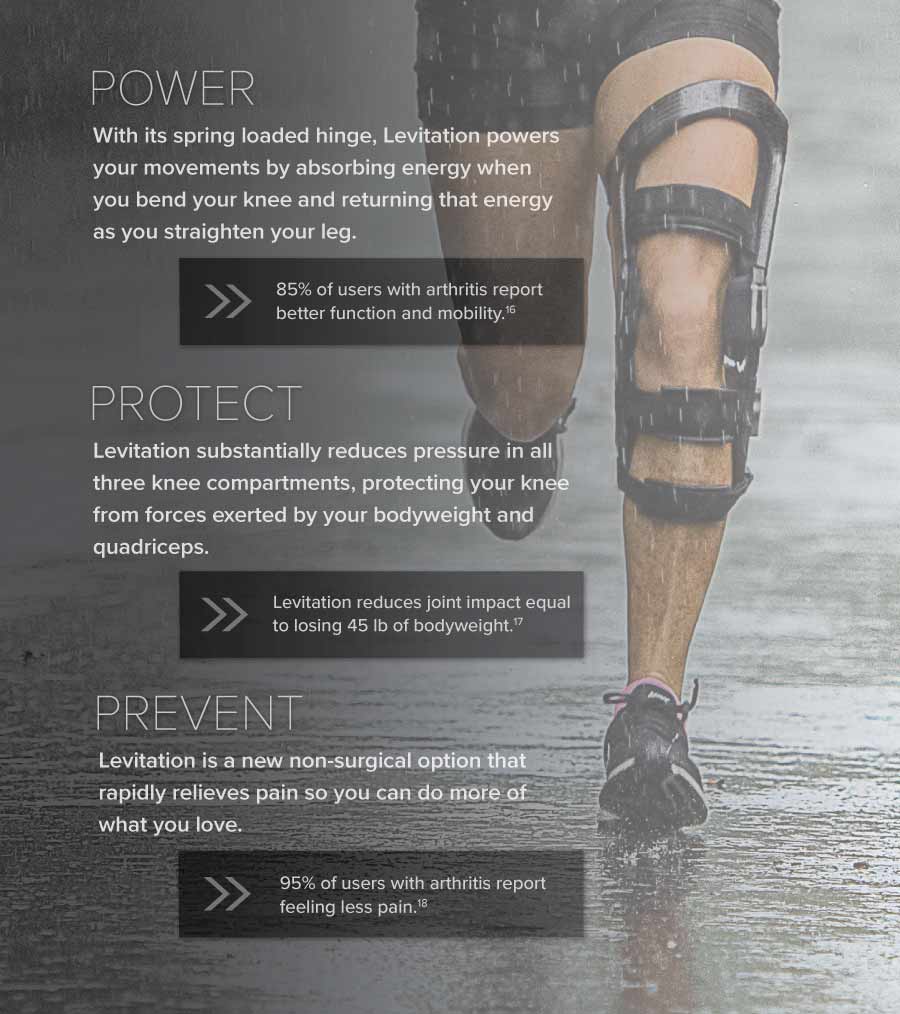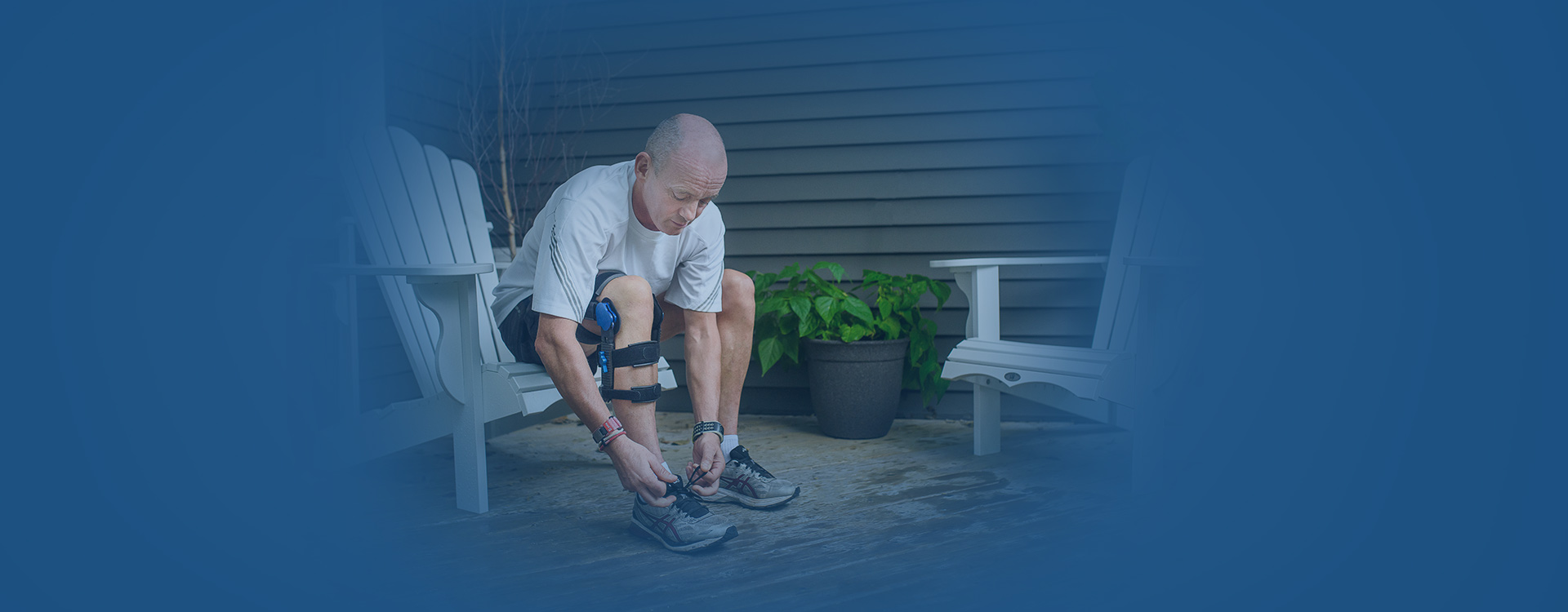
Introduction
What is Long Term Conservative Management of Osteoarthritis?
Conservative treatment of knee osteoarthritis focuses on options that are non-invasive, low risk, and do not place a large financial burden on the patient. Most doctors generally recommended these treatments as the first step in efforts to decrease pain and increase knee joint function.1 If you have concerns about knee surgery and want to try other options, this is a great place to start. Using treatments that fall under the umbrella of conservative care you may be able to delay or completely avoid knee surgery and dramatically decrease your reliance on pain medications.
CONSERVATIVE MANAGEMENT OF KNEE ARTHRITIS: A treatment framework or strategy with the objective of helping you avoid surgery and minimize your reliance on painkillers.
Treating the Cause vs. Treating the Symptoms
Over 650,000 OA patients in the USA chronically consume Anti-Inflammatory drugs such as ibuprofen.2 Additionally, many others receive corticosteroid and hyaluronic acid injections. Despite the widespread use of pharmacological options, scientific evidence suggests that these therapies actually accelerate joint degeneration and the progression of osteoarthritis.3 Think about it, your knee pain is there for a reason. Chemically decreasing your body’s pain signaling ability so you can use your knee normally again, can cause further stress on the areas of your knee that are already damaged. Negative long term side effects are also an issue with painkillers.
Regardless of what treatment(s) you select, a key consideration should be the degree to which it helps you reduce load on your knee joint during day to day activity. Researchers have identified reduced joint loading (or offloading) as a preferred treatment strategy for knee OA.4 It is thought that a reduction in the pressure placed on the knee will decrease the rate of cartilage degeneration which is often exacerbated during periods of stressful activity (jogging, hiking, squatting). In healthy knees, damaged cartilage tends to heal slowly, but in an osteoarthritic knee, the healing response fails, leading to a steady degeneration of the joint. Eventually, this can lead to bone spurs and painful bone on bone pressure. Offloading the knee joint allows pressure to be decreased or redistributed elsewhere. Consequently, pain is reduced and further damage to the cartilage is lessened.
DID YOU KNOW?: 10lbs of weight loss equates to 48000 lbs less compressive load on your knee per mile walked!5
There are two ways in which you can offload and decrease pressure on your knee joint:
- You can increase the strength of the muscles that support the knee joint. Think of your muscles, tendons, and ligaments as your body’s natural shock-absorbing system. They function in a similar manner to the suspension system found in your car. Aerobic exercise and resistance training can increase the capacity of this system.
- Directly reducing the amount of weight that is loaded on to the knee joint. Less weight equates to less pressure! This is typically done through weight loss, walkers or canes, and offloader knee braces.
Multi-Compartment Offloading
When you think about how your knee is offloaded, it is important to remember there are three pressure points (knee compartments) within your knee joint. Some treatments will decrease pressure in all three contact areas or “compartments”, and some will not. Since over half of patients have OA in more than one compartment of the knee,6,11,19-21 treatments that only partially offload the knee will be limiting in terms of their ability to provide relief from symptoms. Solutions that provide multi-compartment offloading are ideal for many suffering from advanced osteoarthritis as the pressure will be reduced across the entire surface of the knee joint.
A study of 1000+ young knees with signs of osteoarthritis found:6
Osteoarthritis Prevalence by Compartment
- Medial Compartment – 15.1%
- Lateral Compartment – 4.7%
- Patella Femoral Compartment – 16.5%
- Medial & Patellofemoral Compartment – 36.3%
- Lateral & Patellofemoral Compartment – 15.1%
- Medial & Lateral Compartment – 8.1%
- All Three Knee Compartments – 5.0%

As described in our treatment guide, the most popular conservative treatment options that also offload the knee joint are weight loss, exercise, and using biomechanical aids.
Exercise: Increasing the strength of your muscles helping you better absorb impact from walking and other activities. This can be accomplished using resistance and/or aerobic exercise.
While regular exercise is important, research shows that improvements in pain and function tend to decline after approximately six months.7 There are a number of possible reasons for this including poor adherence – many find it difficult to keep up exercise routines for long periods of time. Poor exercise choices can also be a factor. The Goldilocks Principle applies here – the amount, type and frequency have to be just right in order to be helpful. Too much of a good thing could make you worse.
Exercise can also be extremely difficult if you have severe symptoms – it can initially cause painful flare-ups and discomfort. If you are struggling to get started or find it difficult to maintain an exercise routine due to pain – a biomechanical aid (canes, walkers, braces) may be for you. These type of devices take the pressure off your knee, decreasing pain which provides the encouragement you need to exercise. If you are interested in starting a home exercise program check out: Your Guide to Exercise for Knee Osteoarthritis.
Weight loss: Reducing body weight directly decreases the amount of stress that is put on the knee during weight-bearing activities.
Weight loss is a more realistic option for those who have severe knee pain, as it doesn’t risk any of the painful flare-ups that can occur during exercise. A 10% decrease in total body weight can lead to a 30% increase in knee function.8 This means weight loss could have a major impact on your knee pain, however, sticking to a diet for a long period of time can be more difficult for some. Over the long term, research has shown that only 12% of individuals maintain their initial weight loss after 3 years.9 Finding the right information on diet and nutrition can also be extremely confusing which is why visiting a certified dietician or nutritionist is often recommended by doctors.
Biomechanical Aids:
Walkers/Canes: Decrease pressure across the entire knee joint by redistributing weight into your upper-body or uninjured leg.
Shoes/Insoles: Can redistribute pressure to healthier areas of the knee. Orthopedic shoes soften the impact on your joints during walking and jogging relieving
Offloader Knee Braces: Osteoarthritis knee braces can shift pressure away from damaged areas of your knee to areas where the cartilage is healthier.
Spring Knee Braces: Combine the benefits from exercise, weight loss and traditional knee bracing technology. These innovative devices are capable of actively increasing joint strength while decreasing pressure on your knee joint by over 40%.10 This makes them a great alternative to knee surgery.
Experts recommend that you make every effort to achieve long term sustainable changes to your lifestyle that include both diet and exercise. Biomechanical interventions can help you get there. Depending on your situation something simple like a cane may be appropriate. However, if you are hoping to be more active, more advanced options like spring knee braces and exoskeletons can help you regain near-normal knee function. These devices can offer:
- Customizable Offloading: Some knee braces and exoskeletons can be quickly configured to support your unique situation by providing:
- Tailored treatment that allows you to gradually decrease device assistance during progressive knee rehabilitation.
- The ability to customize the angle at which knee strength assistance kicks in to support specific activity requirements.
- Quick modifications that can enhance the offloading of a specific area (compartment) of your knee.
- Tri-compartment Offloading: The knee joint has three compartments or pressure points. If you have osteoarthritis, there is a good chance that it is present in more than one area of your knee. Just like weight loss, some knee braces and exoskeletons can decrease pressure across the entire joint. For more details on how osteoarthritis affects the compartments of your knee check out our Guide to Severe Knee Arthritis.
Combine Treatments for More Pain Relief
The triad of exercise, weight loss, and biomechanical assistance can all work synergistically to provide a complete treatment solution. Exercise can be challenging if you are always in pain, which can make maintaining weight loss much more difficult. Using an external knee support (biomechanical device) can decrease pressure on the knee allowing you to exercise, burn calories, strengthen your muscles and beat your knee arthritis. As described above there are four categories of biomechanical assistance devices. See the table below for a full comparison of these devices and their respective features.
Avoiding, Delaying and Enhancing Knee Surgery Outcomes
Conservative management is all about decreasing the need for invasive and/or risky pharmaceutical or surgical treatments. Realistically, many will need knee surgery eventually, but with regular exercise, dieting and supportive bracing it could be significantly delayed.
It is important to note that if you decide to get knee surgery it will not restore your knee back to its original pre-osteoarthritis state. It may also come with lifetime activity limitations. You may be advised to stop playing sports and reduce your participation in recreational activities you normally engaged in before the surgery. All this is to preserve the integrity of the implant for it’s estimated lifetime of 15-20 years. Not following these directions put you at risk for revision surgery, and possibly another knee replacement surgery in the future. This is where devices that provide tri-compartment offloading can work with your knee replacement potentially allowing you to do more for longer. During occasions where you put your new prosthesis under stress, wearing an external knee support decreases the pressure on the replaced knee, possibly increasing the lifespan of the implant. Less load placed on to your new knee may decrease the risk of revision surgery and increase your performance beyond what your surgically replaced knee would otherwise be capable of.
Knee Surgery Is No Longer The Only Option
External supports that provide tri-compartment offloading can help you avoid or delay knee surgery. Check out How Long Do Knee Replacements Last for more information on the benefits and risks.

Offloader Braces for Osteoarthritis
You may have used a knee brace before and had some success in relieving your symptoms. These devices have been around for a long time, and can offer some extra stability and support for your joints. More recently the advent of uni-compartmental offloader knee braces has allowed for the reduction of stress on a single arthritic compartment of the knee. Unfortunately since the majority of patients with severe osteoarthritis have it in more than one knee compartment6 these devices are of limited utility. Tri-compartment offloading just wasn’t possible with traditional knee brace technology.
If you want to see how a tri-compartment offloader compares to a popular uni-compartment offloader on the market, check out this comparison between a Donjoy knee brace and a Spring Loaded knee brace.
The Limitations of Uni-compartmental Offloading Knee Braces
- Redistributing pressure to other areas of the knee may increase the risk of cartilage degeneration in these areas.
- Cannot decrease pressure in the patellofemoral compartment. Consequently, will yield limited pain relief during squatting & kneeling.
- Can only offload one compartment at a time and thus will have limited benefit for multi compartment OA.
Complex exoskeleton technology capable of providing the human body with active support via mechanical components was developed in the 1960’s with military applications in mind. Because of this it was prohibitively expensive for those just looking for relief from their arthritis pain. In 2014 Spring Loaded Technologies delivered the world’s first exoskeleton knee brace hybrid with liquid spring technology. For sufferers of severe knee osteoarthritis this technology provides all of the benefits of a complex industrial grade exoskeleton at a fraction of the price. Avoiding and delaying knee replacement surgery is now a real possibility.
Below, we have saved you time by researching the premier products designed to offload knees with severe osteoarthritis. These products range from traditional knee braces to complex exoskeletons with electronic components.
Should I Be Using a Knee Brace?
It all depends on your current situation, arthritis prognosis, and future goals. Traditional offloader knee braces can be great especially for those suffering from medial uni-compartmental OA. Exoskeletons are promising, particularly for those with multi-compartment osteoarthritis, severe pain and poor function in their affected joint. If you want the best of both worlds, Spring Loaded’s knee brace is an option worth considering. Check out the video below to see how it works:
Spring Loading In Action!
Spring Loaded braces are being used by people all over the world with severe arthritis every day as a non-surgical approach to pain reduction. Below are just a few testimonials from people with severe knee arthritis who are back to doing the things they love using a Spring Loaded knee brace.
Jane Grover – Advanced Stage Osteoarthritis
“My youngest grandkids are 7 and since they’ve been born they’ve heard nanny can’t do this because her knee’s bothering her…but they’re very happy I can do things for them now, I really can’t think of anything I couldn’t do if my grandkids asked me.”
Wayne Moore – Advanced Stage Osteoarthritis
“I am not as fatigued as I used to be, and golf is enjoyable again…I golf as good as I ever golfed and I’m pain free, that’s the most important thing, I couldn’t be happier.”
Bill Horne – Advanced Stage Osteoarthritis
“Prior to using [a Spring Loaded brace] I could not ascend or descend stairs without pain and holding railing. I had to give up Karate. Now I can take stairs much more comfortably and I have taken up a new martial art. [The brace] has given me a new lease on life.”
Bill was diagnosed with arthritis over a decade ago after experiencing a number of knee dislocations in his youth. Over time, his pain got worse and worse until eventually, his surgeon recommended a knee replacement when the pain became unbearable. Bill’s condition was so debilitating that he soon fell into a serious depression. What made it worse for Bill was that he could no longer practice karate—his beloved sport of 40 years. Surgery wasn’t an option for Bill as his wife would have to retire early to help care for him. He was also concerned about the outcome of the surgery as his friends had mixed results – and as he said, “Once a chunk of bone is removed, it’s gone forever.” As a result, Bill spent years searching for an alternative to a knee replacement. Bill tried a number of pain management treatments and had some success with acupuncture, but that didn’t help improve his mobility. He couldn’t go down stairs without sitting and sliding down one step at a time, couldn’t get out of a chair without the use of his arms and simply tying his shoelaces was difficult. Bill took up Iaido, a Japanese martial art, upon a recommendation made by a friend. Things started to look up, but his ability to practice his new sport was limited. Bill had other health concerns too. Having diabetes, his doctor wanted him to lose weight and exercise more to improve his health. The problem with that, however, was that his knee would dislocate whenever he tried going for extended walks. Because of this, following his doctor’s orders was difficult, if not impossible. Since wearing a Spring Loaded knee brace, Bill’s life has transformed. Thanks to Spring Loaded technology, Bill can squat for the first time in 35 years, he practices Iaido without pain, climbs and descends stairs, and takes long walks without fear of dislocating his knees. He has a new lease on life; sometimes thinking the technology is almost too good to be true.
Ron – Cartilage Loss
As an avid hockey player with tired knees and no luck with other braces, Ron was eager to try a Spring Loaded knee brace. Before using the brace, Ron would experience extreme knee swelling by the end of his games and would struggle to get up after falling on the ice. Since wearing a Spring Loaded knee brace to play, Ron can easily get himself back up onto his feet, and his legs don’t swell half as much as they used to.

How is a Spring Loaded Exoskeleton Different From Traditional Knee Braces used to Manage Knee Arthritis?
Uni-compartment Offloader Knee Braces
Offloader knee braces are the standard bracing option for knee arthritis. Conventional offloader braces—oftentimes referred to as uni-compartment offloader knee braces—are designed to shift weight from the medial tibiofemoral compartment of your knee to the lateral tibiofemoral compartment of your knee, or vice versa. While uni-compartment offloader braces are useful for realigning the knee, the problem is that they provide limited relief across the whole knee. So if the damage caused by your arthritis is affecting more than just one compartment, which is the case for the majority of people with osteoarthritis, then a uni-compartment offloader knee brace may not be able to provide the relief and mobility you need.
Spring Loaded’s Multi-Compartment Solution
A substantial amount of the pain and disability you experience because of your severe knee arthritis may arise from damage to the patellofemoral compartment. In the majority of cases the patellofemoral compartment, either on its own or with one of the tibiofemoral compartments, is affected by the disease.11,22,23 Traditional imaging and diagnostic methods ignored or neglected the patellofemoral compartment. This partially led to traditional knee braces being designed to address only a single medial or lateral tibiofemoral compartment of the knee. Those with either bi or tri-compartment damage were left without a bracing solution to meet their needs. Spring Loaded knee braces address this limitation of traditional knee braces. They are the only offloader knee braces on the market designed to significantly reduce forces in all three compartments of your knee. They do this by:
Protection
Pressure increases throughout the knee when it’s bent, reaching up to seven times your bodyweight. Equipped with a patented spring hinge, a Spring Loaded knee brace absorbs bodyweight and assists with leg extension. By absorbing energy and providing an assist, a Spring Loaded brace protects the knee from the forces exerted by bodyweight and the quadriceps.
Prevention of Pain
By reducing bone-on-bone contact in the knee, a Spring Loaded knee brace effectively diminishes pain symptoms. If you have a misalignment of the knee, the optional pneumatic offloader can be added to the Spring Loaded knee brace to realign the knee. This further reduces pain, improves strength and stability, and diminishes the risk of falling.
Added Power
With its spring hinge, a Spring Loaded knee brace absorbs energy when you bend your knee and returns that energy as you straighten your leg. The amount of energy returned by the spring can be adjusted by the power dial. As your strength increases and pain decreases, the power can be dialed back or turned off altogether.
Benefits of a Spring Loaded brace vs. standard arthritis knee braces11
The problem with most conventional (uni-compartment) osteoarthritis braces is that they do not address pain or dysfunction originating in the patellofemoral compartment. This is because for a long time X-rays taken from directly in front of the knee were used as a primary way to diagnose osteoarthritis. X-rays taken from this angle obscure the patellofemoral compartment, so this type of osteoarthritis was largely left undiagnosed. As a result, most of the knee braces designed for people with osteoarthritis focus on reducing the load on the least affected tibiofemoral compartment and redirecting it to the other tibiofemoral compartment. This means that most osteoarthritis knee braces are designed to help those with damage done in just one of the tibiofemoral compartments (about 3-20% of all knee osteoarthritis cases). Meanwhile, a tri-compartment offloader knee brace offloads the whole knee allowing those with damage in more than one compartment (over half of all cases) to benefit from bracing solutions.
How do Spring Loaded Knee Braces Work?
The Idea
It all started when the company’s founders met through a PHD project that focused on developing solutions for real customer problems. They discovered that they shared experiences having worn standard knee braces at some point in their lives. While these were great for providing stability, they were frustrated that the braces did little to help with the mobility required to get back to work, to school, to athletics, and to everyday life. The founders believed there must be a better way, so they started with the basic idea of making a spring knee brace that could make you stronger, more mobile, and less prone to fatigue and injury. After four years of research and development and hundreds of prototypes, the first Spring Loaded braces were made available to the public.
Spring Technology
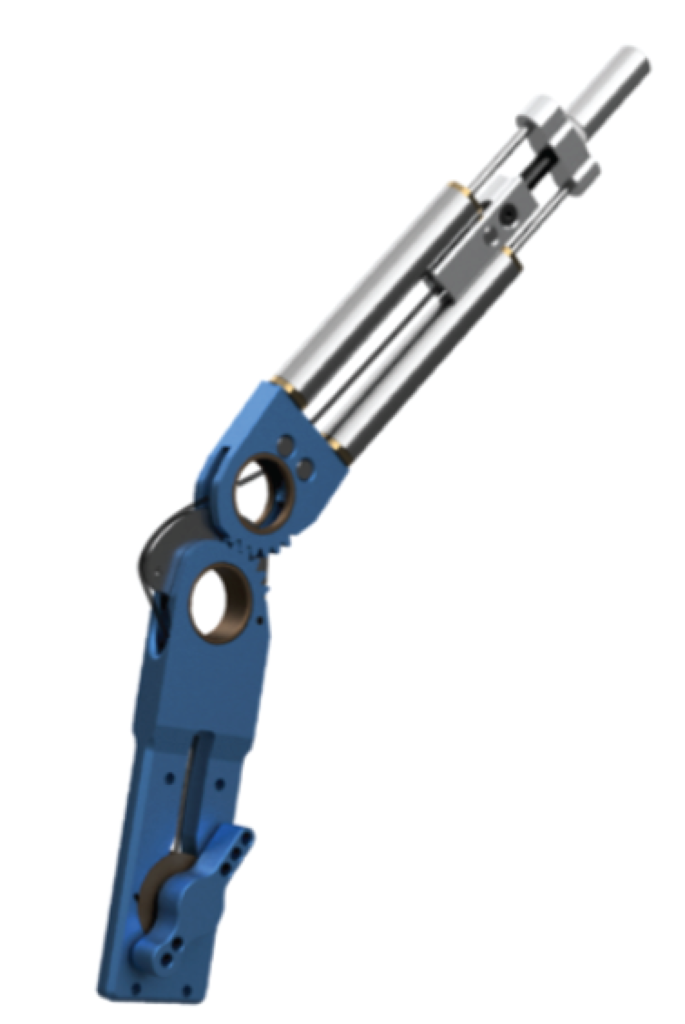
Spring Loaded’s unique proprietary spring works by storing the kinetic energy you create while bending your leg, and then returning that energy as you extend your leg (i.e. getting up from a seated position, climbing stairs, doing a squat movement). This is done through a patented spring inspired by the landing gear on high-performance aircraft. Spring Loaded knee braces allow you to customize the amount of assistance and range of motion to kick in when you need the most help.
Shell
The shell is made with streamlined, lightweight carbon fiber. Because of its lightweight and durability, carbon fiber is used in airplanes, wind turbine blades, high-end sporting equipment, and Formula 1 race cars.
Strapping
Spring Loaded’s proprietary strapping system moves with your leg as it changes shape, keeping your brace in the right place and preventing the brace from slipping down your leg.
How Can I be Sure a Spring Loaded Knee Brace Actually Works?
Spring Loaded knee braces have been on the market since early 2017. While the brace is still considered to be innovative technology, thousands of people from across the world have taken advantage of this unique solution and are back to doing things they didn’t think would be possible again. Many have been kind enough to share their stories. That being said scientific evidence is also extremely important when considering solutions to your medical needs. While a relatively new technology Spring Loaded braces have some promising preliminary research backing their effectiveness.
Research
| Focus | Summary | Findings |
| Biomechanical Analysis10 |
|
|
| Physical Performance Tests13 |
|
|
| Customer Outcomes Survey12 |
|
|
How a Spring Loaded Brace Can Help with Conservative Treatment
Conservative treatment consists of combining exercise, weight loss, and the use of biomechanical aids to treat the symptoms of osteoarthritis. While conservative treatment has the benefit of being non-invasive, it can be difficult to get the pain relief you’re looking for, especially if you’re in the later stages of osteoarthritis. This is because knee pain and other symptoms related to knee osteoarthritis can make it difficult to stay active, which can impact your ability to exercise and burn enough calories to lose weight. Luckily, a Spring Loaded brace can help solve challenges associated with conservative treatment. Read on for more information on how a Spring Loaded brace can help you get the results you want with conservative treatment.
I Use A Mobility Aid, How Could a Spring Loaded Knee Brace Help?14,15
Walkers and Canes are often used to help relieve the pain associated with late-stage osteoarthritis. They both provide relief by bearing some of the weight that would normally be placed on the knee. Scooters or wheelchairs are also used when walking is severely impaired. With wheelchairs and scooters the knees do not bear any weight during movement so the only time the knee would be engaged is while getting in and out of the chair. An issue with assistive devices like the ones mentioned above is that the redirected pressure is distributed to other joints of the body which makes it difficult to use for people with issues in their wrists, elbows or shoulders in some cases. With regard to electric scooters/wheelchairs, they have not been in use long enough to study the full effects of long term use. One issue that may arise from long term use is losing some of the remaining functionality through non-use over an extended period. This would only be a potential issue for those that begin long-term use of these devices while they still are capable of unaided mobility. There is also evidence of an increased risk of falling associated with using walkers and canes. The leading theory is that this increased risk is caused by alterations to a user’s gait as well as the differences in regaining balance when relying on a cane or walker. A Spring Loaded brace uses a patented liquid spring to absorb forces that act on the knee when it bends and extends. This allows for the pain reduction and balance assistance you would get from a cane (or walker) while being able to walk unassisted. A Spring Loaded brace is also adjustable to let you choose when the assist will engage. Once you’ve found the setting that you prefer the only adjustment you would need to make is setting it to high or low power mode depending on the activity. Something else that sets our spring knee brace apart from common mobility aids is that in many cases it can be worn under clothing so you can receive the support you need without drawing any attention.
I’m Considering weight loss, How Could a Spring Loaded Knee Brace Help?
Weight Loss is a great method to reduce the forces acting on the knee, which are the main culprit for the pain and discomfort felt from severe Osteoarthritis. As previously discussed, depending on your knee, all three compartments may be affected by osteoarthritis and not many solutions are designed to address their degeneration. Weight-loss is one of the exceptions as reducing the total amount of weight the knee has to support (bodyweight) reduces the forces acting on the entire knee.
Benefits
Weight loss is a treatment option that can take place without medical intervention in many cases and it has proven effective in reducing the symptoms of severe Osteoarthritis. It doesn’t require a large financial investment to lose weight which sets it apart from other treatments.
Drawbacks
Losing weight at its core can usually only occur under two sets of conditions:
- The calories you take in (from eating/drinking) are LESS than the calories your body burns in an average day (Without Physical Activity).
- The exercise you do burns enough calories to put you in a caloric deficit.
It is often difficult for people with severe Osteoarthritis to exercise due to their advanced symptoms, so a weight loss plan would need to incorporate low-impact exercise with a healthy diet. The amount of benefit you receive will also depend on the total amount of weight loss so it may take a long period of dieting before a noticeable difference in Osteoarthritis symptoms can occur.
Benefits of weight loss with a Spring Loaded brace
The good news is that with our knee bracing technology you effectively get a similar benefit to weight loss in terms of the forces acting on the knee. The reduction in symptoms due to a Spring Loaded brace can also make it easier to lose weight as you may be able to maintain a more intensive exercise routine.
Benefits of a Spring Loaded brace vs. weight loss
With a Spring Loaded knee brace, you will be able to feel the benefit of weight loss on your OA symptoms as soon as you start using the brace. To feel a similar reduction in symptoms you would need to lose up to 40lbs which can take months-years depending on adherence to a diet and exercise plan.
I’m Considering knee strengthening exercise, How Could a Spring Loaded Knee Brace Help?
Knee strengthening exercise can help you keep your knee stable and functional longer. Muscles are part of your body’s natural shock-absorbing system. Since muscle mass tends to decrease naturally with age maintaining strength is particularly important for older individuals.
Benefits
A variety of types of exercise have been proven to help people with OA. Regular participation can reduce pain, increase mobility, enhance muscle strength and allow you to feel more confident with movement.
Drawbacks
- Exercise can be difficult if you are already experiencing joint pain.
- Exercises can be difficult to maintain over long periods of time.
Benefits of exercise with a Spring Loaded brace
A Spring Loaded brace allows you to adjust the degree of strength assistance during knee flexion. This is an important feature for rehabilitating the knee, as it allows you to work within a range that is comfortable for you. As you get stronger and more confident you can dial back the assistance and move more under your own power.
Benefits of a Spring Loaded brace vs. exercise
The effectiveness of exercise depends largely on how well you adhere to your training schedule and the severity of your osteoarthritis. If done properly you will slowly gain muscle mass and strength leading to improved knee function. Spring Loaded Braces allow you to achieve those strength gains instantly. Think about it as strapping on a new set of thigh muscles.

How Do I Know if a Spring Loaded Brace is Right For Me?
Consultation with a bracing specialist
If you would like to find out if you are a good candidate for a Spring Loaded brace give us a call at 1.877.209.8780 to speak with a bracing specialist or click here to book a consultation at your convenience. After discussing your knee(s) they will have a better sense of whether or not a Spring Loaded brace could help you.
Consultation with your doctor
After speaking with a bracing specialist it is always a good idea to talk to your primary care physician to get their advice on the matter and to obtain a prescription. We have an information package available for doctors that one of our bracing specialists will be able to provide you!
Insurance
Our brace is covered by many Canadian and United States insurance companies. If you are eligible to receive coverage through the Canadian Veterans Office or a provincial Workers Compensation Board we have seen complete coverage from those groups and would recommend starting there!
Financing
We offer a flexible payment plan option for our Canadian and US customers to help cover the cost of our braces. Speak to a bracing specialist for more information on your payment options.
Purchase
To purchase a Spring Loaded brace give us a call at 1.877.209.8780, provide us with your measurements and preferred payment method, and we can begin processing your order. All of our braces are manufactured at our location in Nova Scotia, Canada. The sooner you get in touch the sooner we can begin building your brace!
Learn More – Book Your Free Consultation Here
or give us a call at 1.877.209.8780
References
- Crawford, D. C., Miller, L. E., & Block, J. E. (2013). Conservative management of symptomatic knee osteoarthritis: a flawed strategy?. Orthopedic reviews, 5(1).
- Dillon, C. F., Rasch, E. K., Gu, Q., & Hirsch, R. (2006). Prevalence of knee osteoarthritis in the United States: arthritis data from the Third National Health and Nutrition Examination Survey 1991-94. The Journal of rheumatology, 33(11), 2271-2279.
- Briem, K., Axe, M. J., & Snyder‐Mackler, L. (2009). Medial knee joint loading increases in those who respond to hyaluronan injection for medial knee osteoarthritis. Journal of Orthopaedic Research, 27(11), 1420-1425.
- Snijders, G., den Broeder, A., van Riel, P., Straten, V., de Man, F., … van den Hoogen, F. (2011). Evidence-based tailored conservative treatment of knee and hip osteoarthritis: between knowing and doing. Scandinavian Journal of Rheumatology, 40(3), 225–231.doi:10.3109/03009742.2010.530611
- Messier, S. P., Gutekunst, D. J., Davis, C., & DeVita, P. (2005). Weight loss reduces knee‐joint loads in overweight and obese older adults with knee osteoarthritis. Arthritis & Rheumatism, 52(7), 2026-203
- Mohammed, K.S. Al-Obaedi, O. Shah, M. (2018). Prevalence of Compartmental Osteoarthritis of the Knee in an Adult Patient Population: A Retrospective Observational Study. EC Orthopaedics
- Nicolson, P. J. A. (2018). Adherence to exercise among people with knee osteoarthritis (Doctoral dissertation).
- Christensen, R., Astrup, A., & Bliddal, H. (2005). Weight loss: the treatment of choice for knee osteoarthritis? A randomized trial. Osteoarthritis and Cartilage, 13(1), 20-27.
- Grodstein, F., Levine, R., Troy, L., Spencer, T., Colditz, G. A., & Stampfer, M. J. (1996). Three-year follow-up of participants in a commercial weight loss program: can you keep it off?. Archives of Internal Medicine, 156(12), 1302-1306.
- McGibbon, C. & Mohamed, A. Knee Load Reduction From an Energy Storing Mechanical Brace. Canadian Society for Biomechanics (2018)
- Duncan, R. C., Hay, E. M., Saklatvala, J., & Croft, P. R. (2006). Prevalence of radiographic osteoarthritis—it all depends on your point of view. Rheumatology, 45(6), 757-760.
- Spring Loaded Knee Brace & Customer Experiences. (2019) Spring Loaded Technologies.
- The effect of an energy storing knee brace on performance in military personnel. (2016) Spring Loaded Technologies
- Moe, R. H., Fernandes, L., & Østerås, N. (2012). Daily use of a cane for two months reduced pain and improved function in patients with knee osteoarthritis. Journal of physiotherapy, 58(2), 128.
- Thoreau, R. (2015). The impact of mobility scooters on their users. Does their usage help or hinder?: A state of the art review. Journal of transport & health, 2(2), 269-275.
- Based on a retrospective systematic survey of Spring Loaded knee brace users with knee osteoarthritis.
- Budarick A, et al. Design and Mechanical Evaluation of a Novel Multi-Compartment Offloader Knee Brace. J Biomech Eng. 2019 Sep 1. doi: 10.1115/1.4044818.[Epub ahead of print].
- Based on a retrospective systematic survey of Spring Loaded knee braceusers with knee osteoarthritis.
- McAlindon, T., Zhang, Y,, Hannan, M., Naimark, A., Weissman, B., Castelli, W., & Felson, D. (1996). Are risk factors for patellofemoral and tibiofemoral knee osteoarthritis different?. J Rheumatol, 23(2), 332-337.
- Stefanik, J. J., Guermazi, A., Roemer, F.W., et al. (2016). Changes in patellofemoral and tibiofemoral joint cartilage damage and bone marrow lesions over 7 years: the Multicenter Osteoarthritis Study. Osteoarthritis Cartilage, 24(7), 1160-1166.
- Lankhorst, N.E., Damen, J., Oei, E.H, et al. (2017). Incidence, prevalence, natural course and prognosis of patellofemoral osteoarthritis: the Cohort Hip and Cohort Knee study. Osteoarthritis Cartilage, 25(5), 647-653.
- Hart, H. F., Stefanik, J. J., Wyndow, N., Machotka, Z., & Crossley, K. M. (2017). The prevalence of radiographic and mri-defined patellofemoral osteoarthritis and structural pathology: A systematic review and meta-analysis. British Journal of Sports Medicine, 51(16), 1195-1208.
- Kobayashi, S., Pappas, E., Fransen, M., Refshauge, K., & Simic, M. (2016). The prevalence of patellofemoral osteoarthritis: A systematic review and meta-analysis. Osteoarthritis and Cartilage, 24(10), 1697-1707.

